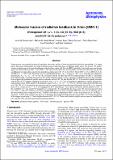Por favor, use este identificador para citar o enlazar a este item:
http://hdl.handle.net/10261/204122COMPARTIR / EXPORTAR:
 SHARE SHARE
 CORE
BASE CORE
BASE
|
|
| Visualizar otros formatos: MARC | Dublin Core | RDF | ORE | MODS | METS | DIDL | DATACITE | |

| Título: | Molecular tracers of radiative feedback in Orion (OMC-1): Widespread CH+ (J = 1-0), CO (10-9), HCN (6-5), and HCO+ (6-5) emission |
Autor: | Goicoechea, Javier R. CSIC ORCID; Santa-Maria, Miriam G. CSIC ORCID; Bron, Emeric CSIC ORCID; Teyssier, D.; Marcelino, Nuria CSIC ORCID; Cernicharo, José CSIC ORCID ; Cuadrado, Sara CSIC ORCID | Palabras clave: | Planetary nebulae: general ISM: clouds Infrared: galaxies Galaxies: ISM |
Fecha de publicación: | 1-feb-2019 | Editor: | Springer Nature | Citación: | Astronomy and Astrophysics 622: A91 (2019) | Resumen: | Young massive stars regulate the physical conditions, ionization, and fate of their natal molecular cloud and surroundings. It is important to find tracers that quantify the stellar feedback processes that take place on different spatial scales. We present -85 arcmin velocity-resolved maps of several submillimeter molecular lines, taken with Herschel/HIFI, toward the closest high-mass star-forming region, the Orion molecular cloud 1 core (OMC-1). The observed rotational lines include probes of warm and dense molecular gas that are difficult, if not impossible, to detect from ground-based telescopes: CH (J = 1-0), CO (J = 10-9), HCO (J = 6-5), HCN (J = 6-5), and CH (N, J = 1, 3/2-1, 1/2). These lines trace an extended but thin layer (AV ≃ 3-6 mag or ~10 cm) of molecular gas at high thermal pressure, P = nH · Tk ≈ 107-109 cm K, associated with the far-ultraviolet (FUV) irradiated surface of OMC-1. The intense FUV radiation field - emerging from massive stars in the Trapezium cluster - heats, compresses, and photoevaporates the cloud edge. It also triggers the formation of specific reactive molecules such as CH+. We find that the CH (J = 1-0) emission spatially correlates with the flux of FUV photons impinging the cloud: G0 from ~10 to ~10. This relationship is supported by constant-pressure photodissociation region (PDR) models in the parameter space P=G ≈ [5 × 10 - 8 × 10] cm K where many observed PDRs seem to lie. The CH+ (J = 1-0) emission also correlates with the extended infrared emission from vibrationally excited H (v ≫ 1), and with that of [C II] 158 μm and CO J = 10-9, all emerging from FUV-irradiated gas. These spatial correlations link the presence of CH+ to the availability of C+ ions and of FUV-pumped H2 (v ≫ 1) molecules.We conclude that the parsec-scale CH emission and narrow-line (δ ≃ 3 km s) mid-J CO emission arises from extended PDR gas and not from fast shocks. PDR line tracers are the smoking g of the stellar feedback from young massive stars. The PDR cloud surface component in OMC-1, with a mass density of 120-240 M⊙pc, represents ~5-10% of the total gas mass; however, it dominates the emitted line luminosity, the average CO J = 10-9 surface luminosity in the mapped region being ~35 times brighter than that of CO J = 2-1. These results provide insights into the source of submillimeter CH+ and mid-J CO emission from distant star-forming galaxies. | Descripción: | 22 pags.; 17 figs., 3 tabs., 3 apps. | Versión del editor: | http://dx.doi.org/10.1051/0004-6361/201834409 | URI: | http://hdl.handle.net/10261/204122 | DOI: | 10.1051/0004-6361/201834409 | Identificadores: | doi: 10.1051/0004-6361/201834409 issn: 1432-0746 |
| Aparece en las colecciones: | (CFMAC-IFF) Artículos |
Ficheros en este ítem:
| Fichero | Descripción | Tamaño | Formato | |
|---|---|---|---|---|
| aa34409-18.pdf | 22,28 MB | Adobe PDF |  Visualizar/Abrir |
CORE Recommender
PubMed Central
Citations
1
checked on 18-may-2024
SCOPUSTM
Citations
21
checked on 18-may-2024
WEB OF SCIENCETM
Citations
22
checked on 25-feb-2024
Page view(s)
120
checked on 20-may-2024
Download(s)
104
checked on 20-may-2024
Google ScholarTM
Check
Altmetric
Altmetric
Artículos relacionados:
NOTA: Los ítems de Digital.CSIC están protegidos por copyright, con todos los derechos reservados, a menos que se indique lo contrario.
